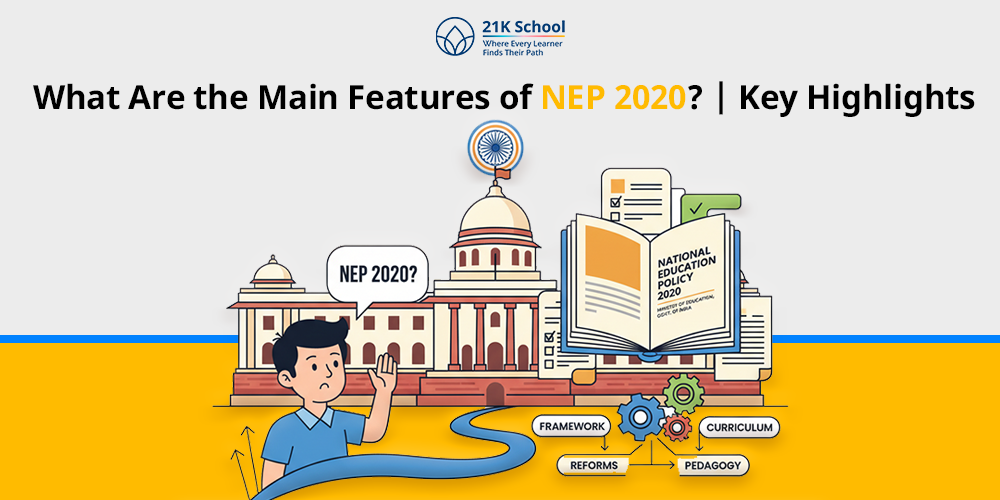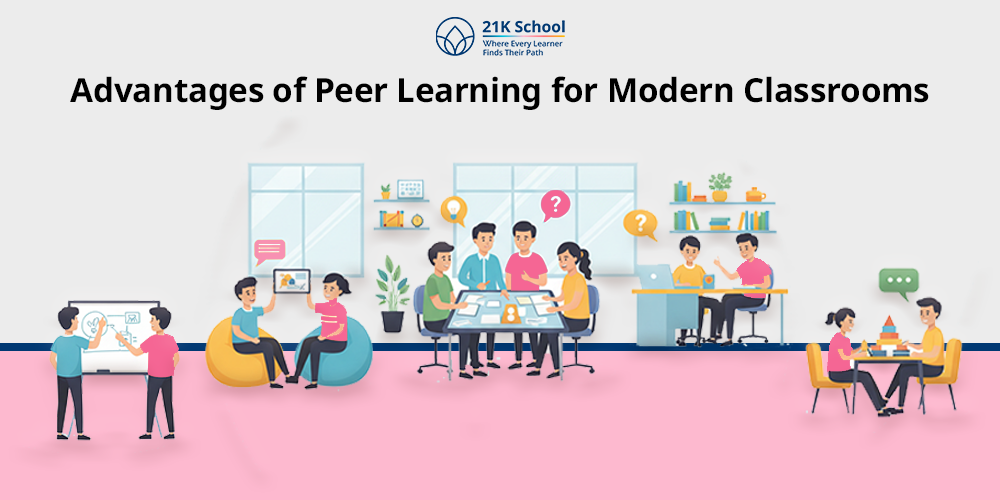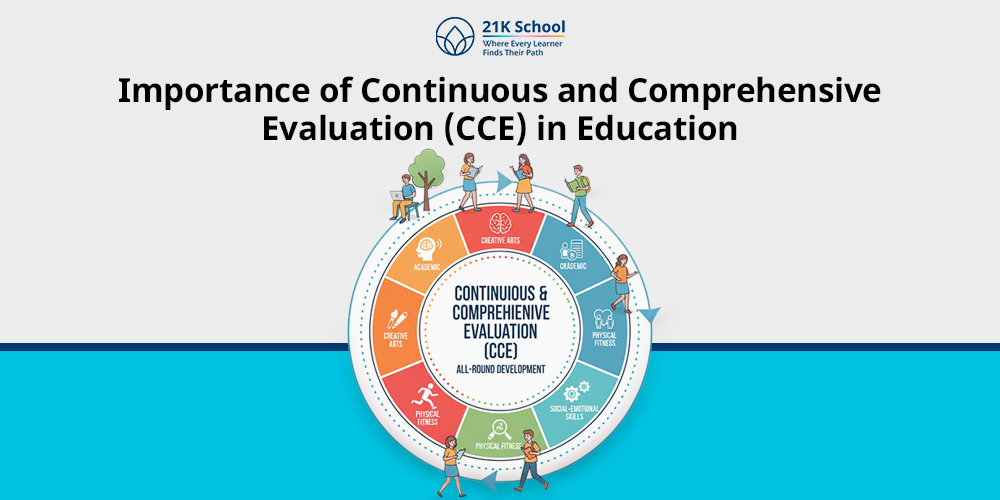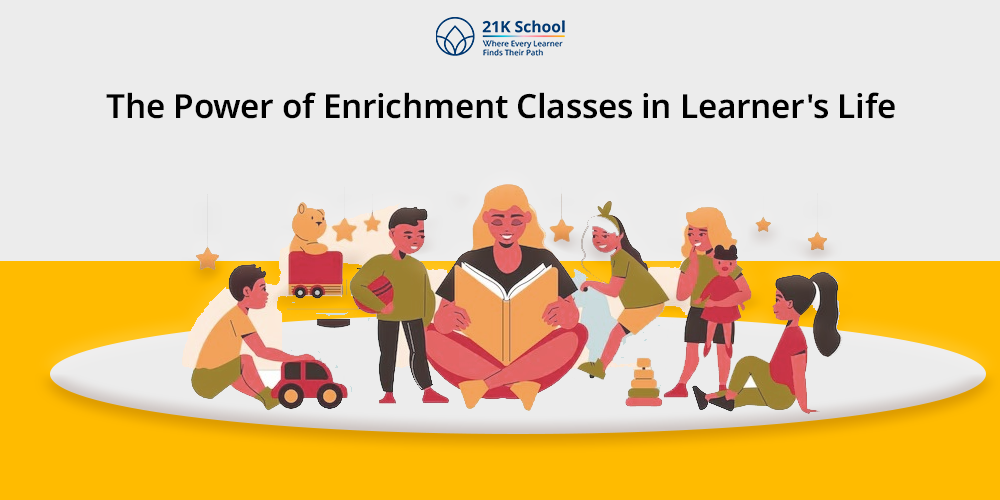
Have you ever wondered why kids truly enjoy things that they are really interested in? Whether it’s creative painting ideas , building virtual robots , or exploring fun learning activities ?
This is exactly what enrichment classes in learners’ lives aim to nurture. As we grow and upgrade in new classes, education feels like a race to reach the finish line.
From the curriculum to pass exams, it’s easy to overlook the importance of learning experiences that are creative, hands-on, and personally meaningful.
That’s the time enrichment classes take place. These classes are not on common textbook topics. It helps learners to increase curiosity, strengths, and hidden passions.
Here we will understand what enrichment classes are, how these classes are beneficial learners. Explore these valuable experiences into a learner’s life. Let’s dive in!
Contents
- 1 What Are Enrichment Classes?
- 2 Examples of Enrichment Classes
- 3 Types of Enrichment Classes
- 4 The Benefits of Enrichment Classes
- 5 How To Implement Enrichment Classes in Schools?
- 6 Challenges and Solutions to Implement Enrichment Classes
- 7 Tips for Parents to Encourage Learners for Enrichment Classes
- 8 Conclusion
What Are Enrichment Classes?
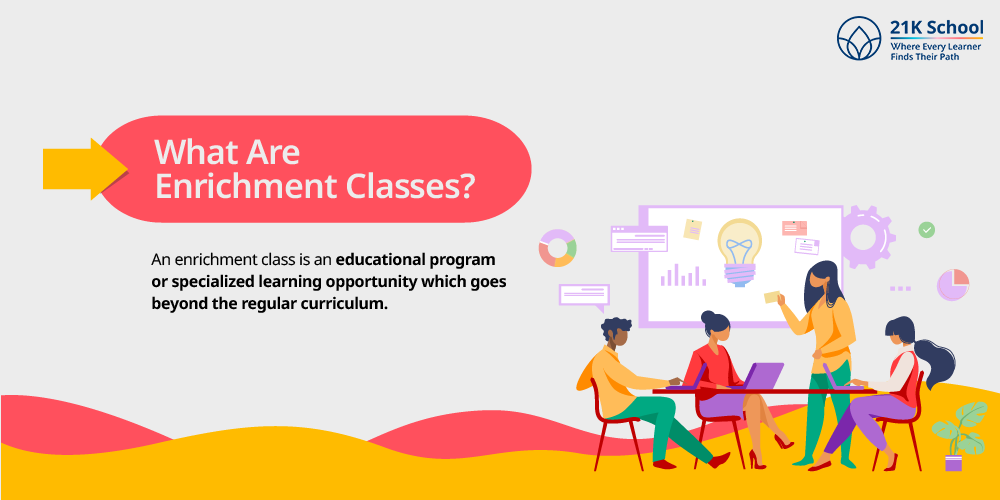
An enrichment class is an educational program or specialized learning opportunity which goes beyond the regular curriculum.
It offers additional challenges, in-depth exploration of subjects, and personalized learning experiences designed to learners abilities and interests.
Also read: The benefits of personalized learning .
The objective of these kinds of classes is to focus on creative thinking, critical reasoning, real-world skills, and individual interests, providing a holistic learning experience.
Parents often look for enrichment classes to enhance their child’s intellectual, emotional, and social development.
Examples of Enrichment Classes
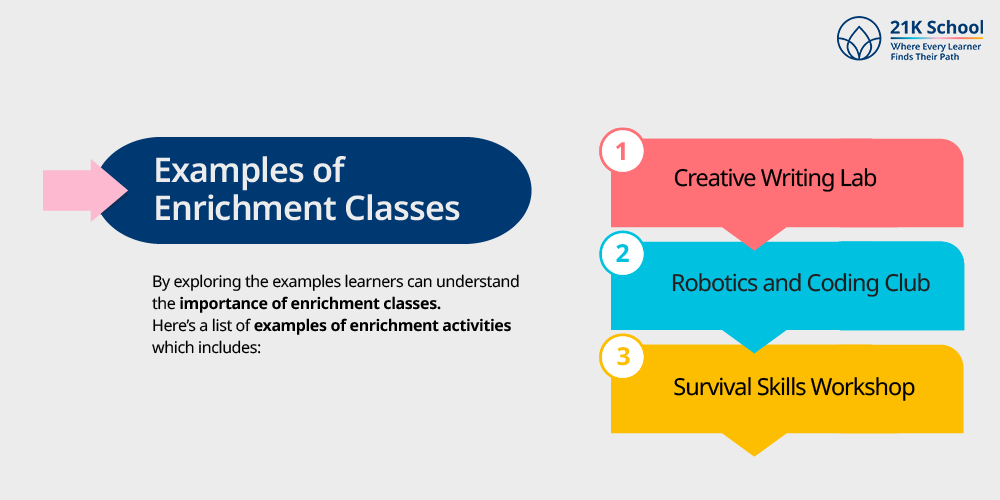
By exploring the examples learners can understand the importance of enrichment classes. Here’s a list of examples of enrichment activities which includes:
1. Creative Writing Lab
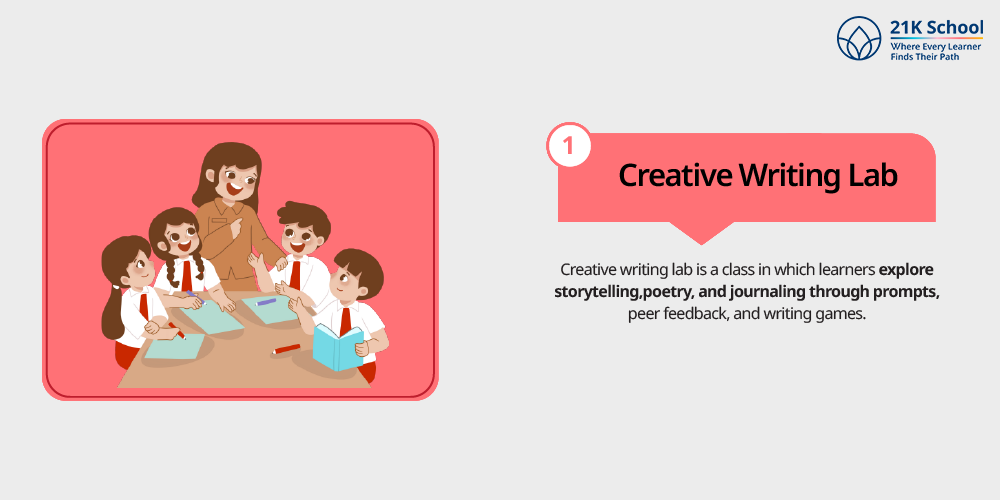
Creative writing lab is a class in which learners explore storytelling, poetry, and journaling through prompts, peer feedback, and writing games. Emphasis is on voice, imagination, and narrative structure.
2. Robotics and Coding Club
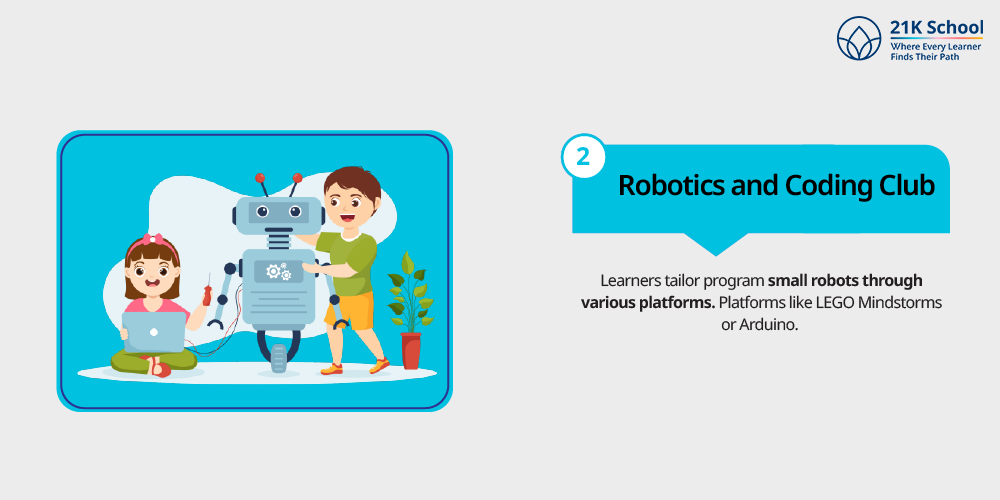
Learners tailor program small robots through various platforms. Platforms like LEGO Mindstorms or Arduino. They learn logic, basic engineering, and team collaboration.
3. Survival Skills Workshop
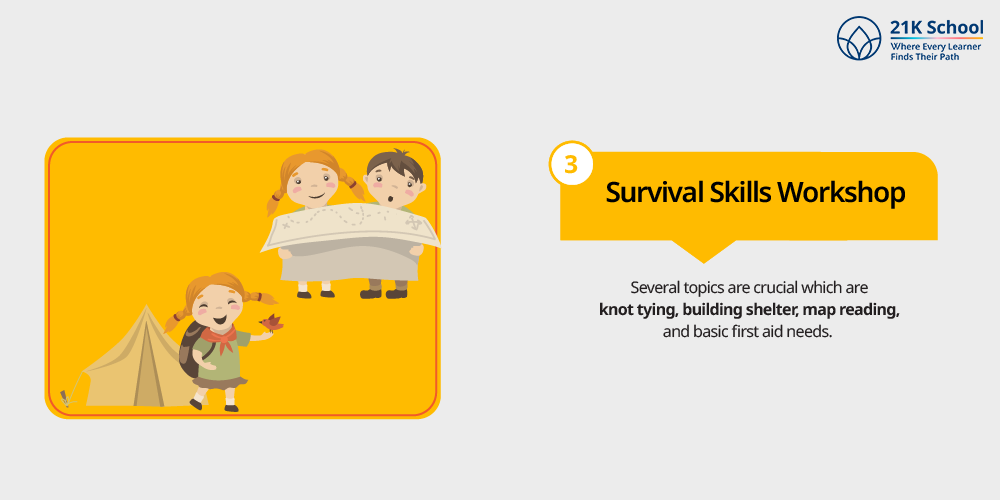
Several topics are crucial which are knot tying, building shelter, map reading, and basic first aid needs. It is for urban or outdoor environments.
Types of Enrichment Classes
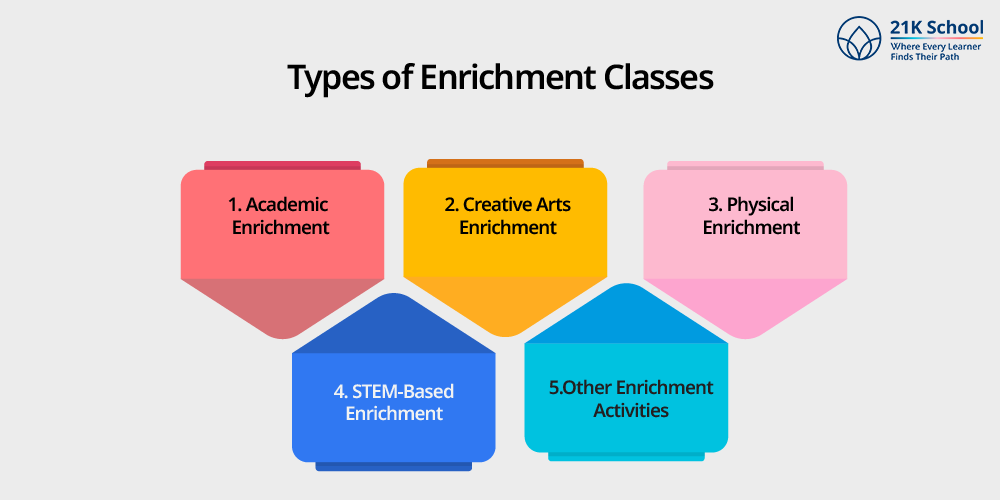
Enrichment classes had a wide range of activities which are categories in different forms. These can be categorized into academic, creative arts, physical, and STEM-based enrichment.
Each category helps in discovering new interests, deepening knowledge in specific areas, or developing basic life skills .
Let’s explore the common types of enrichment classes, based on category:
1. Academic Enrichment
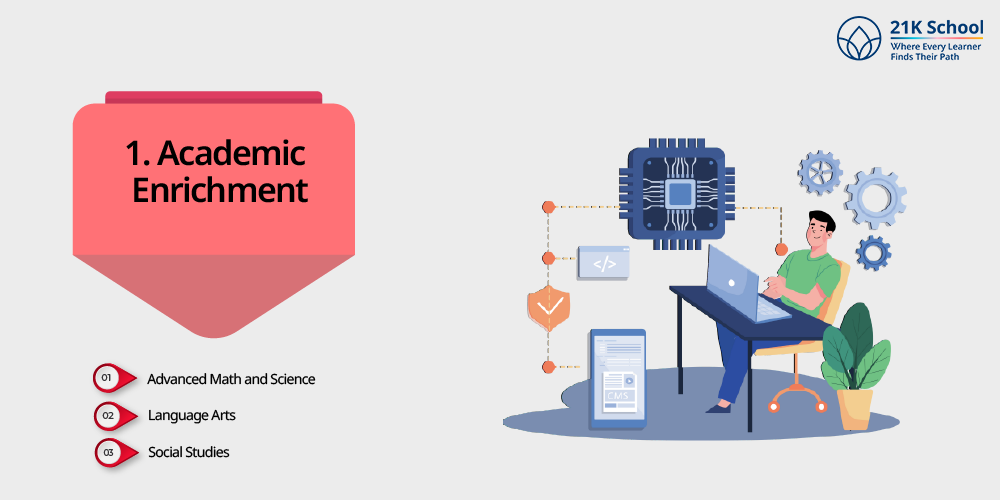
- Advanced Math and Science: Various advanced math and science courses that delve into complex concepts and problem-solving techniques , focus to understand deeper.
- Language Arts: Language arts include creative writing, critical analysis of literature, and participation in debate clubs or academic competitions. It will improve learners’ communication and critical thinking.
Learn how to develop critical thinking skills in students to foster academic growth.
- Social Studies: Encourages learners to explore history and current events from multiple perspectives. It can be done through research, discussions, or simulations.
2. Creative Arts Enrichment
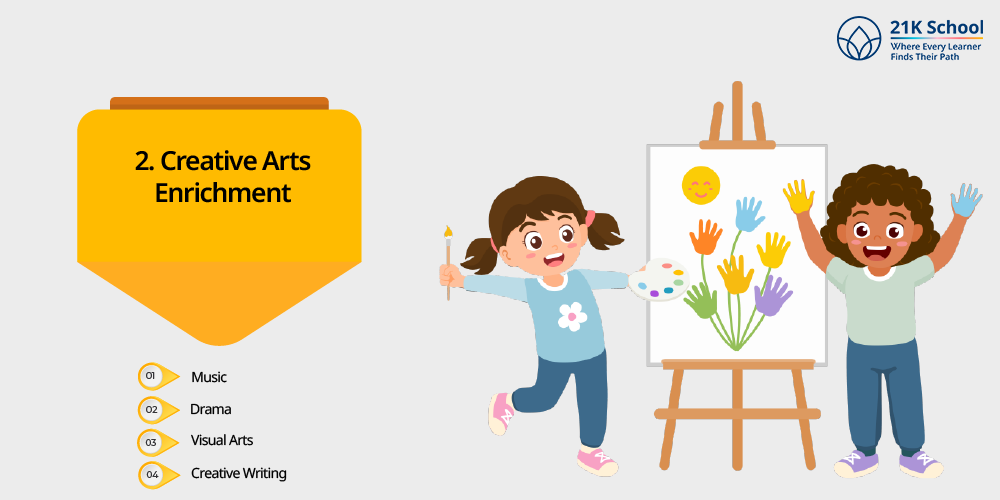
- Music: It includes learning instrumental lessons, vocal training, or exploring music production.
- Drama: Attend acting classes, improvisational workshops, or participate in theatrical productions etc.
- Visual Arts: Visual Arts such as painting, sculpting, drawing, exploring different art forms to explore interests.
- Creative Writing: Motivate expressive storytelling, poetry, and writing in different genres, helping students find their voice and improve written communication.
3. Physical Enrichment
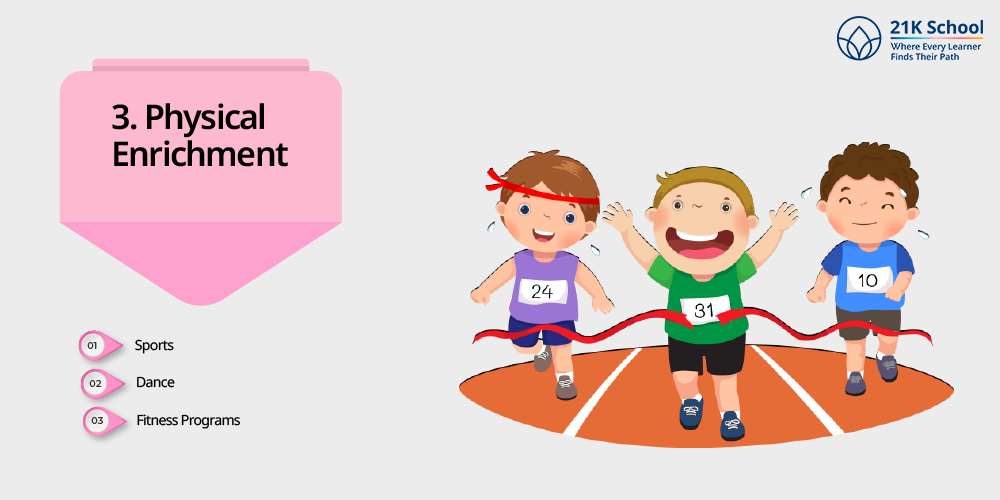
- Sports: Participating in various sports teams or taking specialized sports lessons will teach discipline, teamwork, and physical fitness.
- Dance: Learning different dance forms such as ballet, hip-hop classical etc and participating in performances classes are physical enrichment.
- Fitness Programs: Developing healthy habits and improving physical fitness leads to strengthening individuals’ health. One can do yoga, strength training, or aerobic workouts.
4. STEM-Based Enrichment
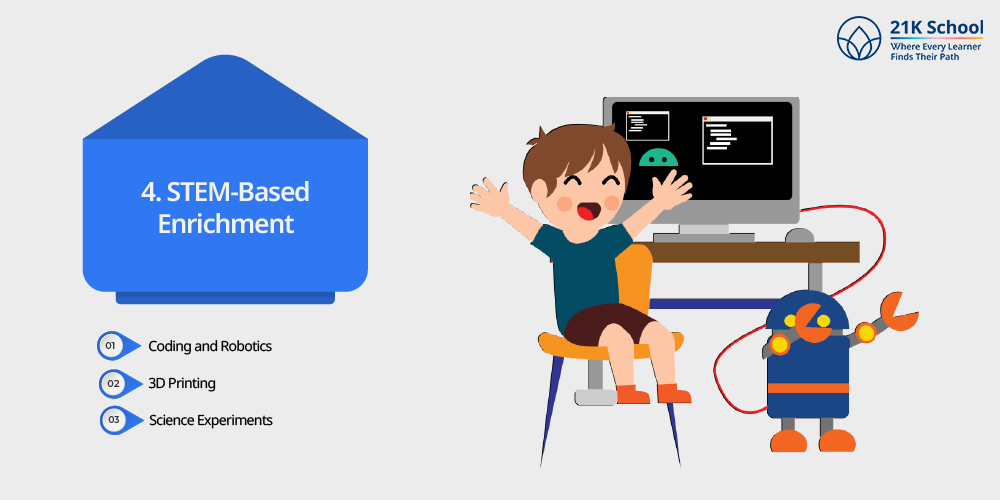
- Coding and Robotics: STEM-Based Enrichment includes learning the fundamentals of coding for kids , building robots, and participating in coding competitions.
- 3D Printing: One can explore the technology and create 3D models and prototypes to learn new things.
- Science Experiments: Participating in simple science experiments and other research projects that increase learners’ interests beyond curriculum.
5. Other Enrichment Activities
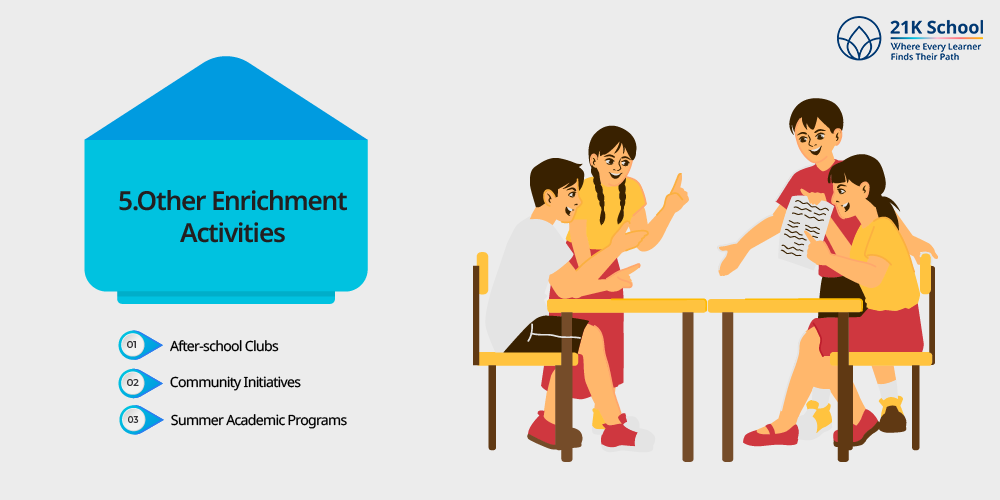
- After-school Clubs: In these kinds of enrichment classes, learners book clubs, debate clubs, or other clubs focused on specific interests.
- Community Initiatives: Community initiatives include volunteering in the community and participating in various service projects.
- Summer Academic Programs: Summer academic programs consist of different kinds of intensive courses to improve learners’ knowledge and skills in specific subjects.
The Benefits of Enrichment Classes
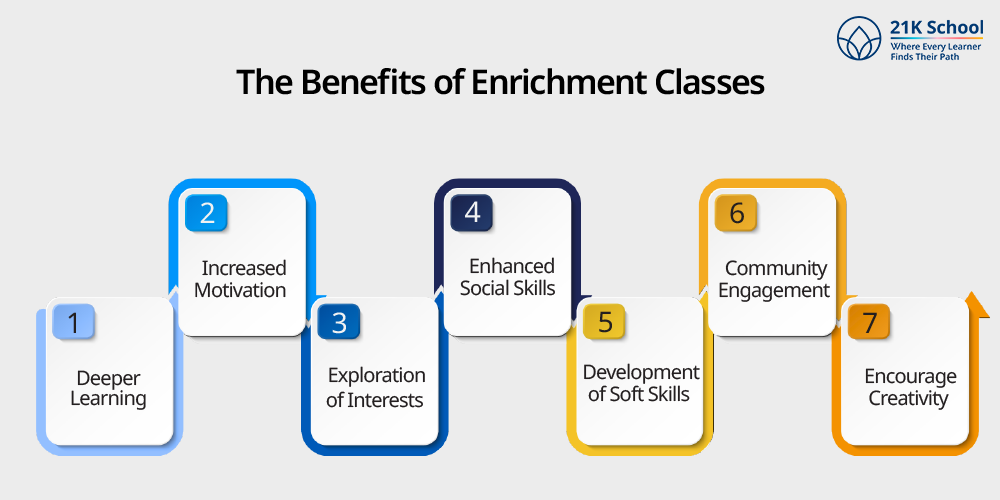
Enrichment classes are beneficial for learners and help in enhanced cognitive development of children , improved academic performance, and the development of crucial soft skills.
Here is a detailed look on the beneficial of enrichment classes:
1. Deeper Learning
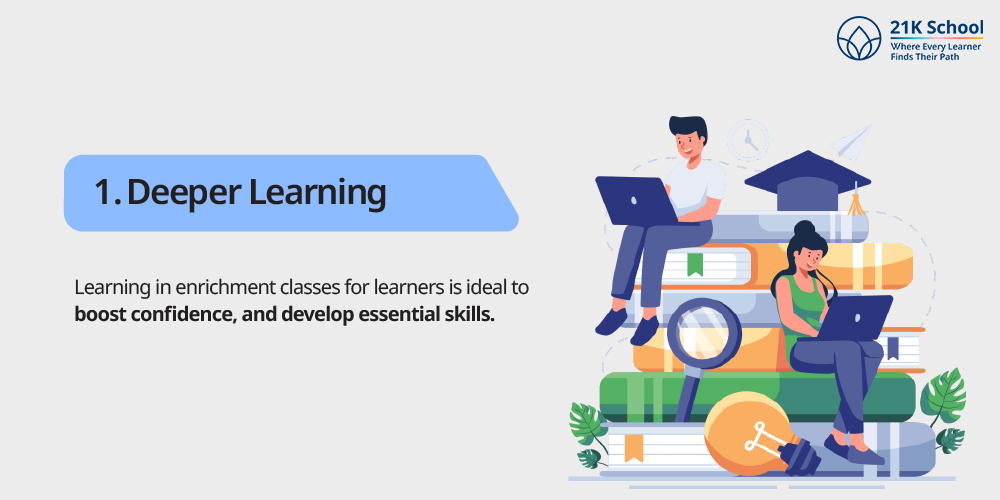
Learning in enrichment classes for learners is ideal to boost confidence, and develop essential skills. These classes provide opportunities to explore other subjects in detail.
This type of learning is generally not offered in the regular classroom, promoting a deeper understanding and long-term retention.
The classes create spark in learners by helping them to choose the desired content which makes learning more meaningful and enjoyable.
2. Increased Motivation
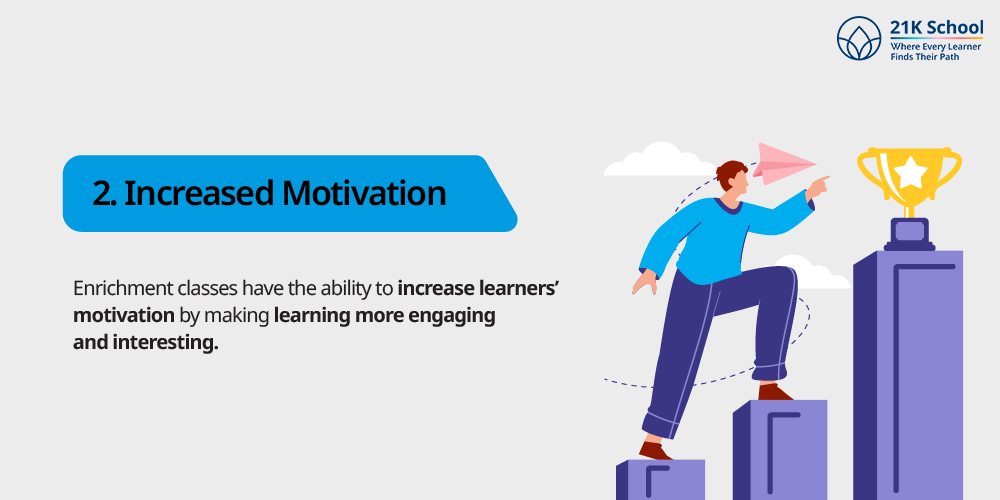
Enrichment classes have the ability to increase learners’ motivation by making learning more engaging and interesting.
It starts with a deeper understanding of subjects and later encourages exploration of new interests. To reduce academic pressure these classes are ideal.
Enrichment classes in learners’ lives offer a relaxed learning environment and can lead to improved academic performance to become more enthusiastic about learning.
3. Exploration of Interests
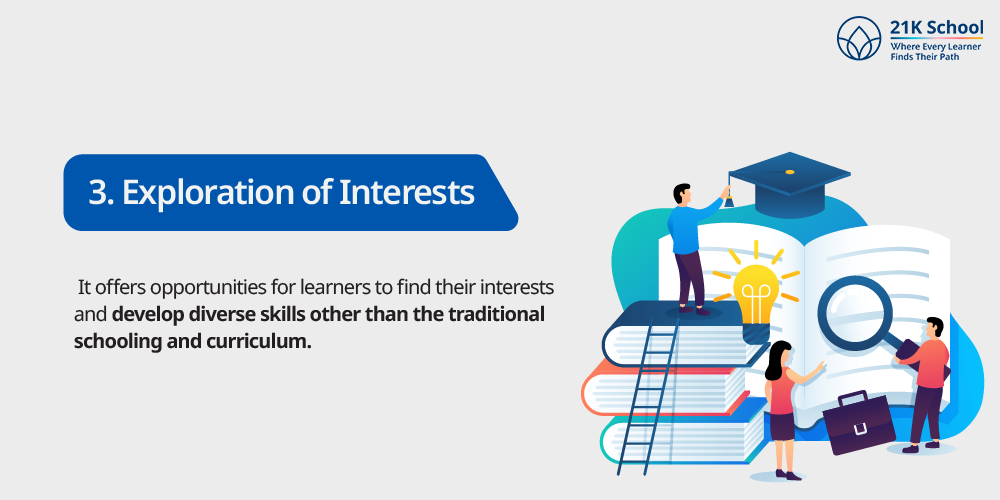
Exploration of interests in enrichment classes has numerous benefits.
Initially it offers opportunities for learners to find their interests and develop diverse skills other than the traditional schooling and curriculum.
These classes are all about creativity, enhance social skills, and boost confidence, while also complementing academic education.
Whether it’s a simple science experiment, programming, or debating on traditional vs modern education , enrichment classes guide learners to discover what excites them.
4. Enhanced Social Skills
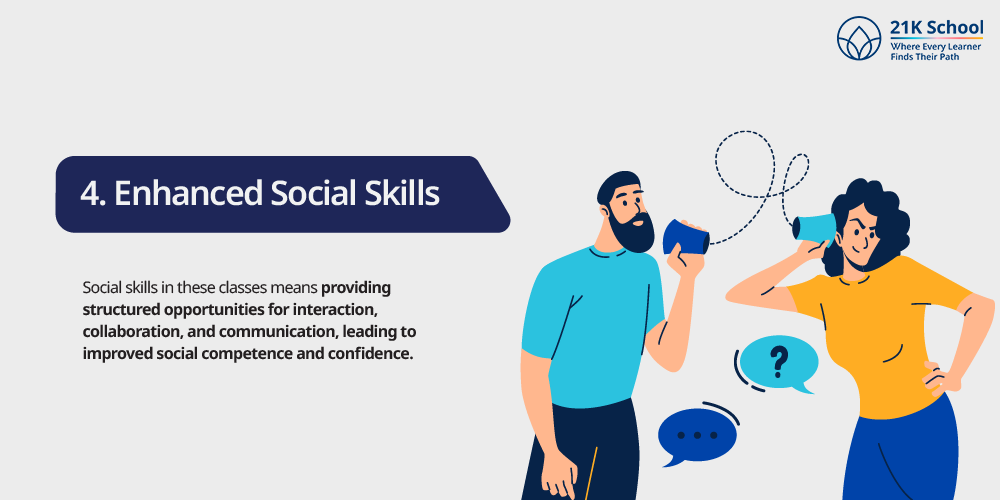
Enrichment classes enhance social skills of learners who participate with dedication.
Social skills in these classes means providing structured opportunities for interaction, collaboration, and communication, leading to improved social competence and confidence.
Kids learn to work effectively with their peers, develop empathy with them and build stronger relationships than before.
These social interactions are not only vital for a child’s academic development but also personal growth.
5. Development of Soft Skills
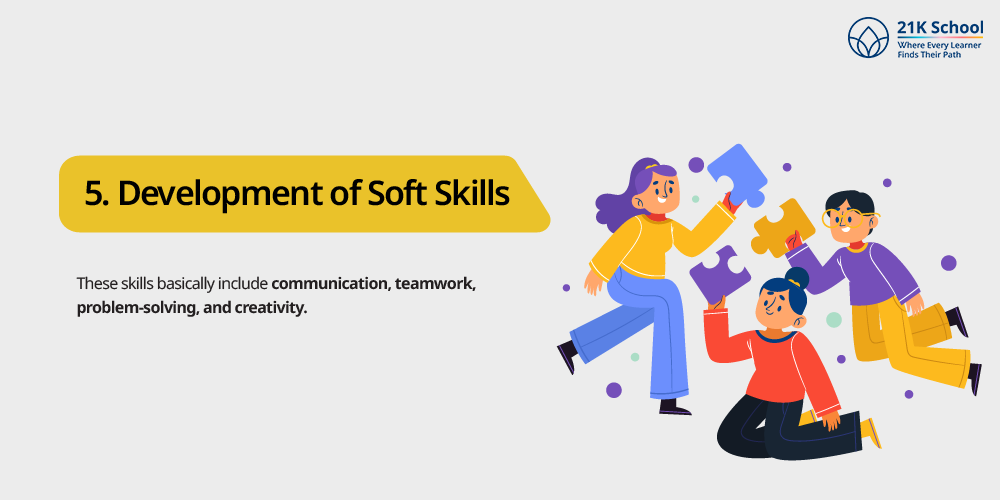
Enrichment classes also provide a valuable opportunity for learners to develop soft skills.
These skills basically include communication, teamwork, problem-solving , and creativity. Each of them are important for both personal and professional success.
As a learner, enrichment programs provide a supportive environment and lifelong learning opportunity.
6. Community Engagement
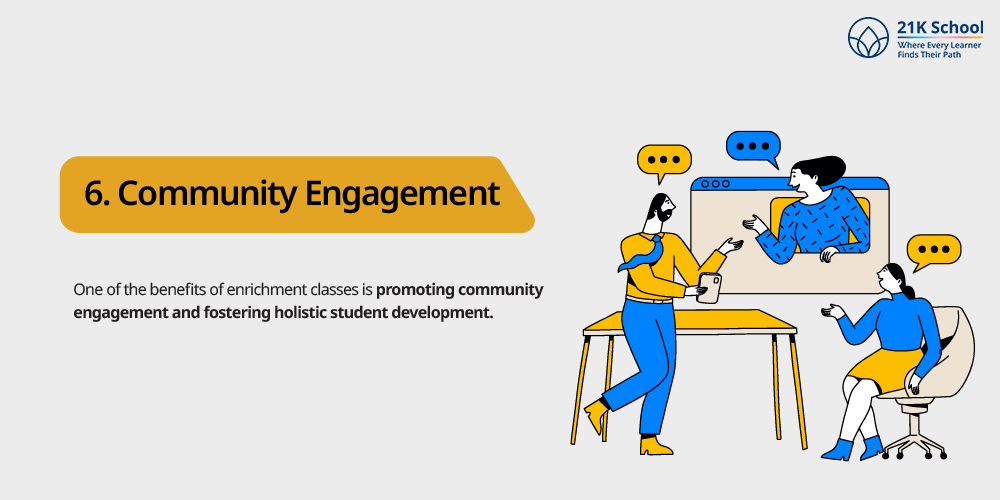
One of the benefits of enrichment classes is promoting community engagement and fostering holistic student development.
Explore holistic education for kids’ development in the 21st century.
Here kids can opt for new interests which they never got a chance to learn. It helps them to develop essential skills, and build social connections.
It boosts confidence, and encourages a lifelong love of learning. Enrichment teachers about civic responsibility and helping them connect with their local communities.
7. Encourage Creativity
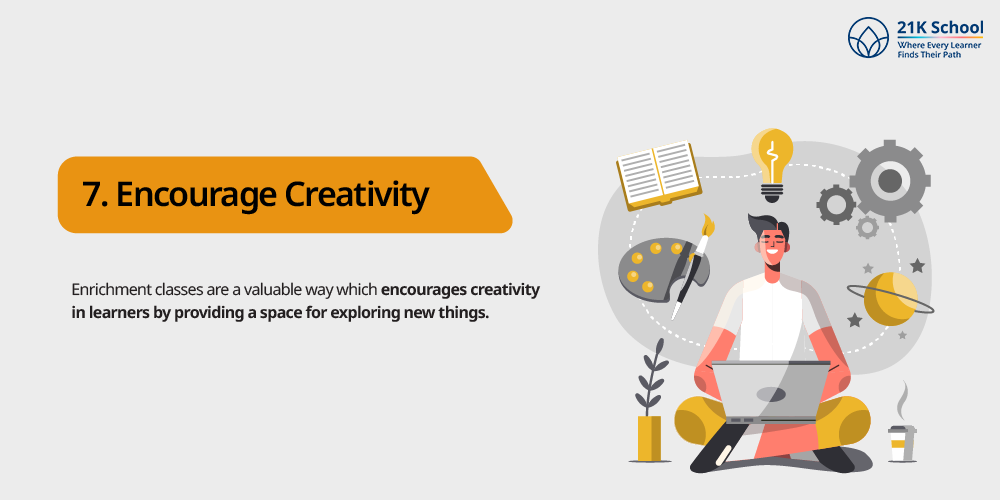
Enrichment classes are a valuable way which encourages creativity in learners by providing a space for exploring new things.
An individual enhances his abilities when he or she participates in activities and collaborates for learning. This helps them to think outside the box and develop innovative solutions.
Understand why is creativity important to child development .
These classes also enhance cognitive development, social skills, and self-confidence, ultimately preparing children for future academic and personal success.
How To Implement Enrichment Classes in Schools?
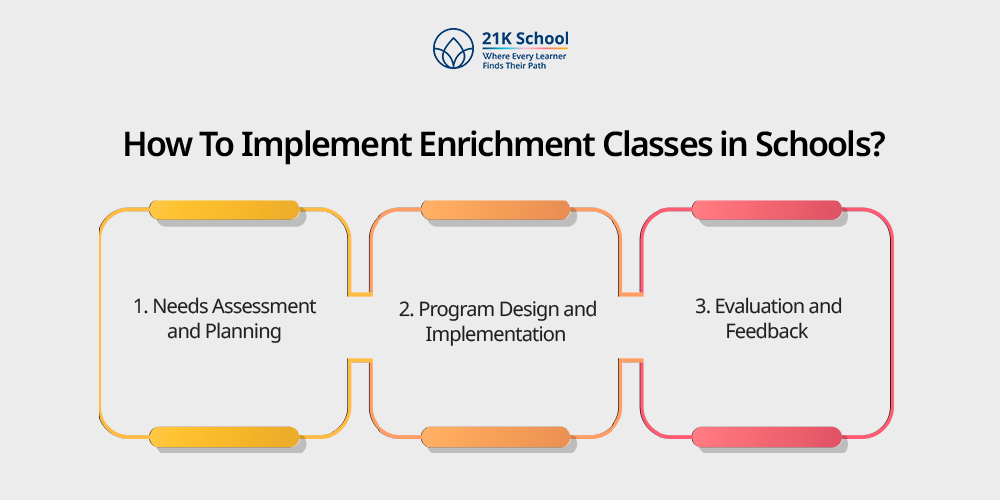
Implementation of enrichment classes in schools helps in spreading awareness towards inclusive classroom environments and assesses improvement.
Schools can begin by identifying student needs and interests, then design programs that offer diverse learning experiences, potentially through community partnerships and technology integration.
Here’s a more detailed breakdown:
1. Needs Assessment and Planning
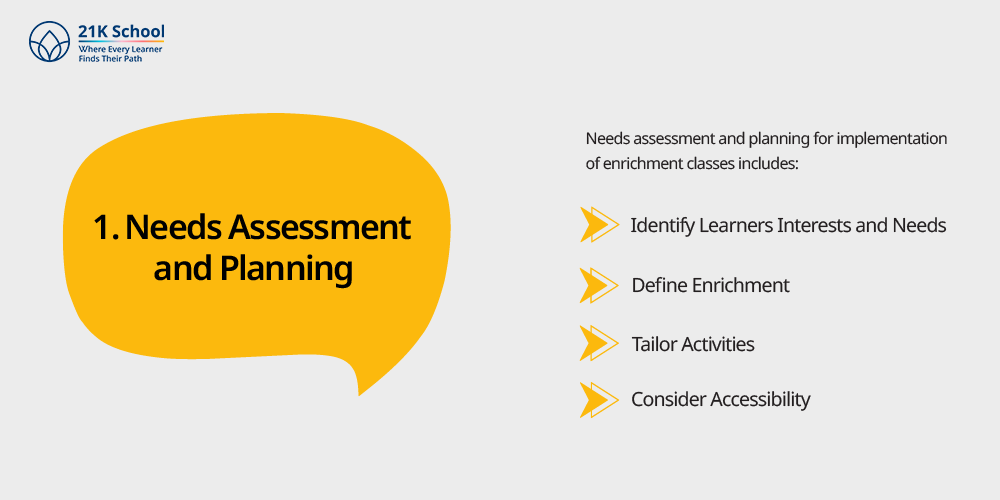
Needs assessment and planning for implementation of enrichment classes includes:
i) Identify Learners Interests and Needs
By conducting various surveys, polls, or informal discussions with learners and parents one can identify learners interests and needs. Understanding their preferences and learning gaps can fulfill requirements.
ii) Define Enrichment
Define enrichment means identifying the scope and focus of the program. It can be academic, artistic, social-emotional etc.
iii) Tailor Activities
By adaptation of the ongoing program to different age groups and learning styles, ensuring age-appropriate and engaging activities.
iv) Consider Accessibility
Learners and facilitators should ensure that programs are accessible to everyone without any boundaries, background or ability.
2. Program Design and Implementation
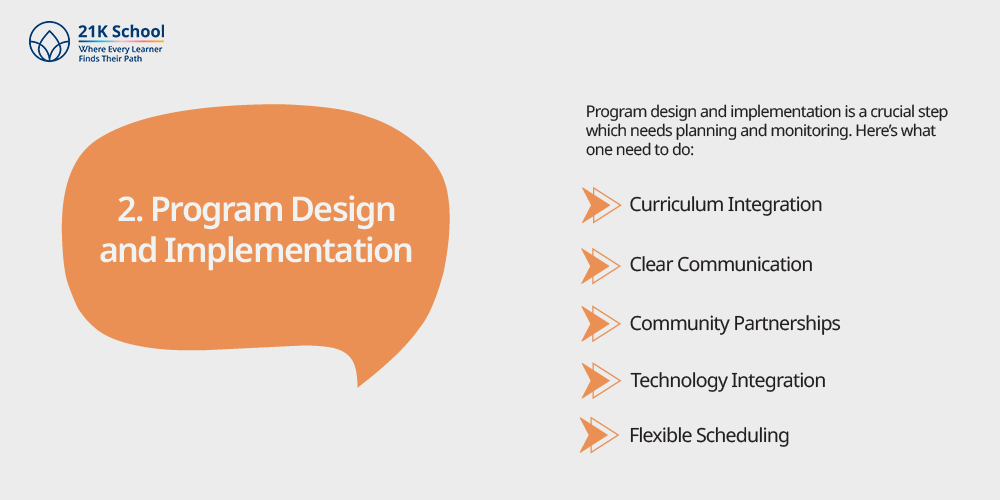
Program design and implementation is a crucial step which needs planning and monitoring. Here’s what one need to do:
i) Curriculum Integration
Adding enrichment activities for learners into their regular curriculum is ideal to improve their skills in day-to-day life.
ii) Clear Communication
Provide clear information about the start and end of the program, registration, and policies to ensure positive feedback.
iii) Community Partnerships
Collaborate with local organizations, businesses and other experts to offer unique learning opportunities.
iv) Technology Integration
Technology integration helps schools to implement without any challenges. Use various online resources and tools to enhance learning and streamline program administration.
v) Flexible Scheduling
Learners always look for flexibility in learning. To accommodate different schedules one can program before, during, or after school, or during the summer.
3. Evaluation and Feedback
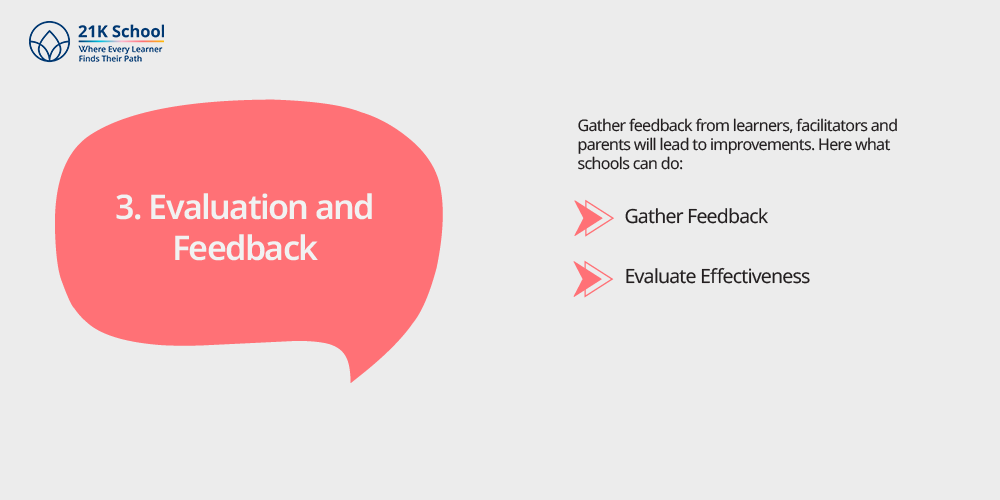
Gather feedback from learners, facilitators and parents will lead to improvements. Here what schools can do:
i) Gather Feedback
Continuously gathering feedback from learners, facilitators and parents to refine the program in future.
ii) Evaluate Effectiveness
By analysing the assessment data and gathering feedback information will help schools to identify areas for improvement.
Challenges and Solutions to Implement Enrichment Classes
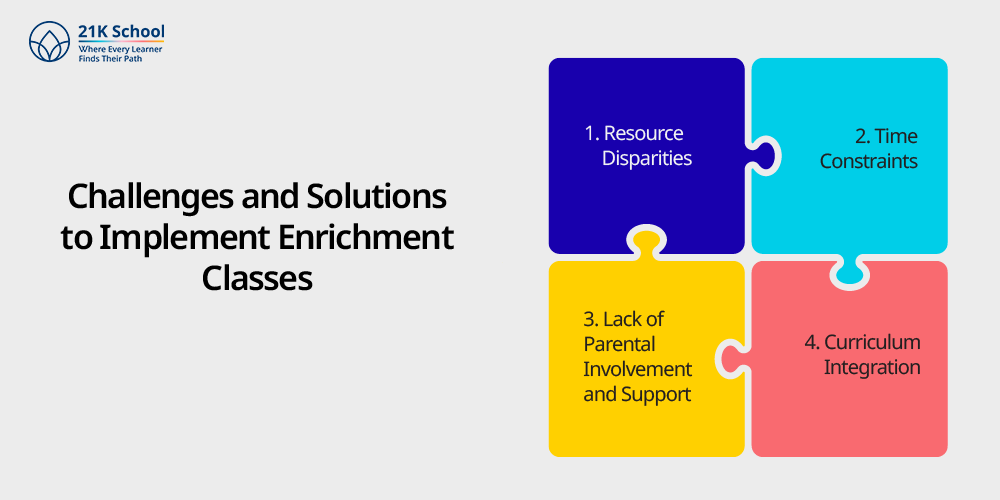
Implementing enrichment classes in school leads to several challenges such as limited resources, diverse student needs, and ensuring effective curriculum integration.
Understanding these challenges are vital to find solutions accordingly. Here’s some common challenges of implementing enrichment classes:
1. Resource Disparities
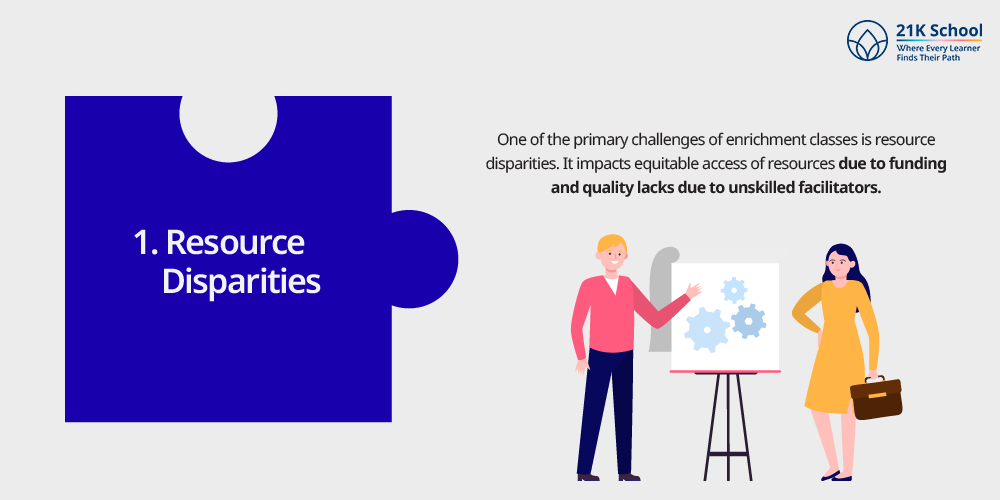
One of the primary challenges of enrichment classes is resource disparities. It impacts equitable access of resources due to funding and quality lacks due to unskilled facilitators.
Addressing these disparities requires strategic solutions focused on funding, resource allocation, and innovative approaches to curriculum and instruction. Collaboration with NGOs can be helpful.
2. Time Constraints

Time constraints are a common challenge faced while implementing enrichment classes. It requires careful planning and resource management.
Many facilitators find it difficult to balance the requirements of core curriculum with the need for specialized activities.
Effective strategies to overcome this issue include optimizing class schedules, utilizing blended learning approaches, and leveraging technology to enhance learning opportunities.
3. Lack of Parental Involvement and Support
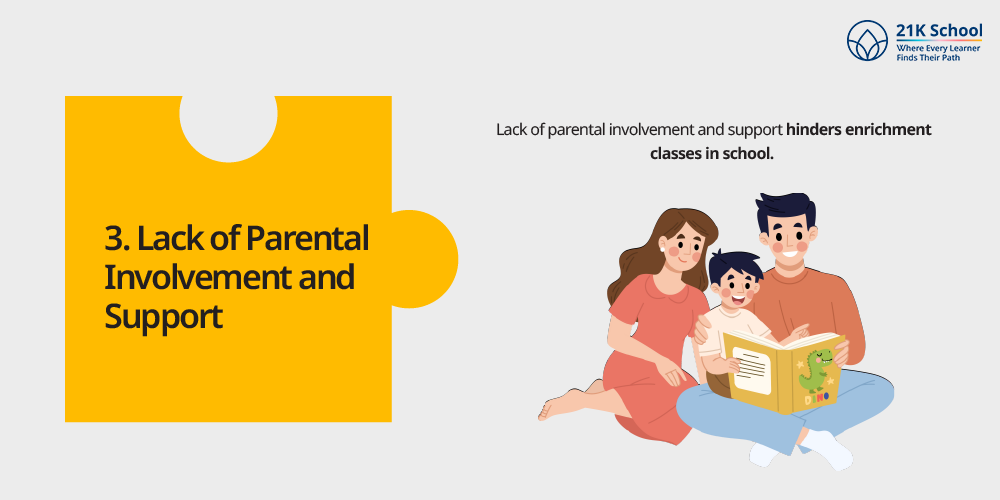
Lack of parental involvement and support hinders enrichment classes in school.
To resolve this problem schools need to use strategies such as improved communication skills , flexible scheduling, and community partnerships.
4. Curriculum Integration
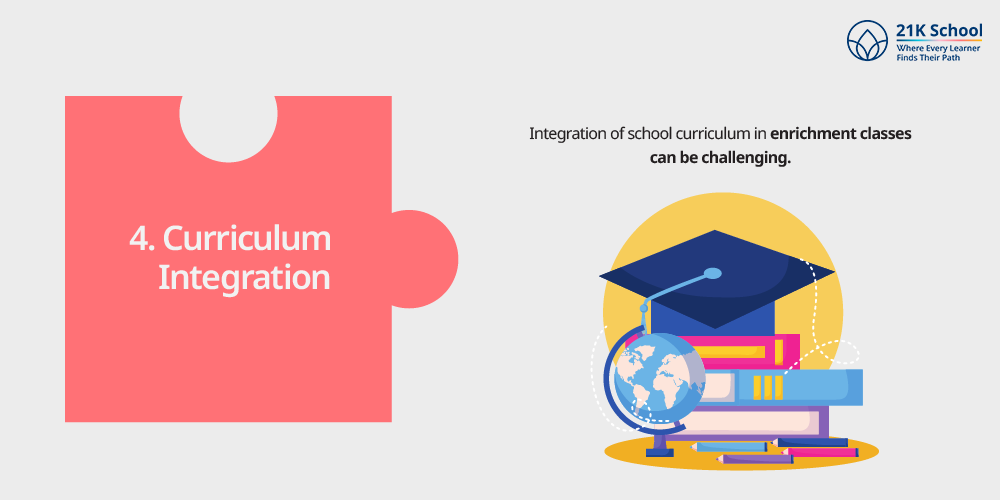
Integration of school curriculum in enrichment classes can be challenging. It’s difficult to align with kids’ needs, follow school rules while staying flexible, and deal with limited resources.
To solve these challenges, facilitators need to work together, get training to learn new ideas, and have enough resources.
It’s also crucial to make learning fun, useful, and connected to real life so students stay interested and involved.
Tips for Parents to Encourage Learners for Enrichment Classes
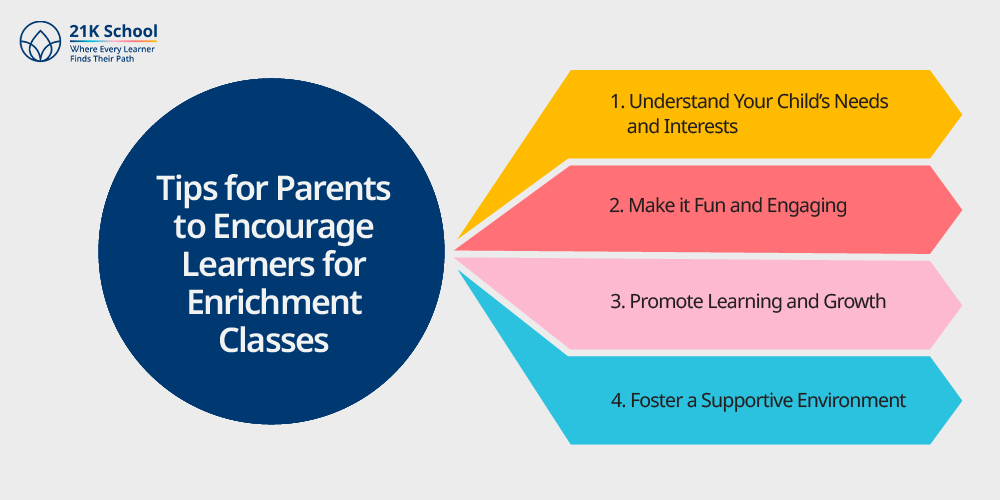
Enrichment classes encourage learners to participate in various activities. Parents can focus on creating a positive environment and behavior towards learning.
This makes it enjoyable and connects it to their kid’s interests. Communication with the child and facilitators will provide a supportive environment to learn.
Here you can go through tips for parents to encourage learners for enrichment classes:
1. Understand Your Child’s Needs and Interests
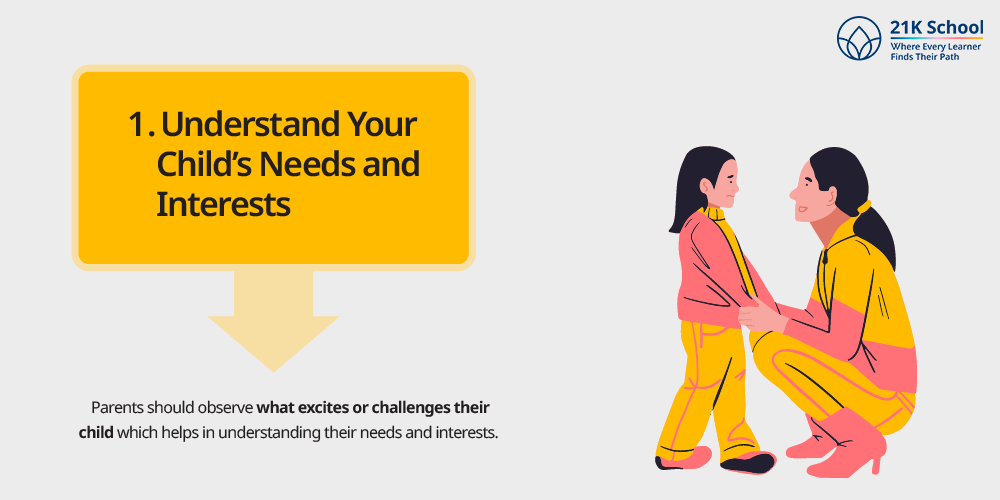
Parents should observe what excites or challenges their child which helps in understanding their needs and interests.
This can be done by talking with them about their passions. Whether they want to take part in art, science, music or technology.
Let them choose enrichment classes that align with those interests. When kids do what interests them they are more likely to be enthusiastic participants.
2. Make it Fun and Engaging
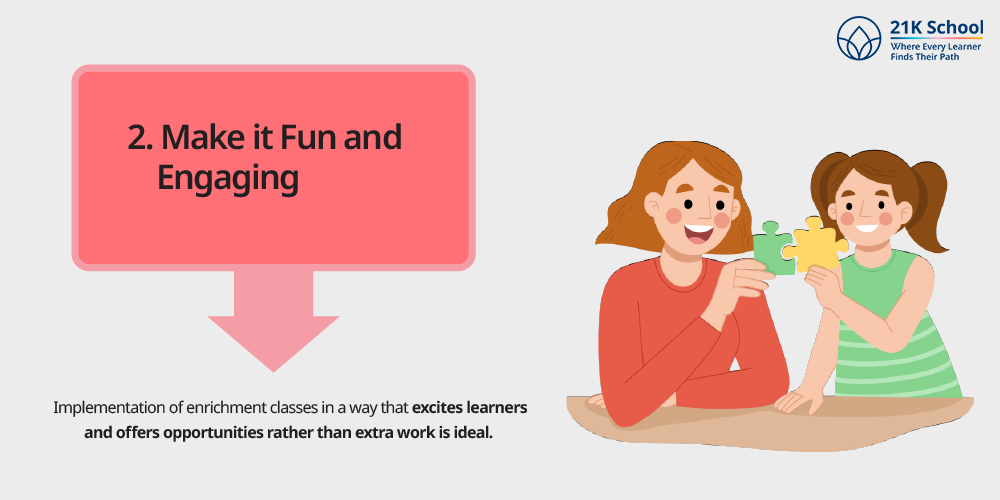
Implementation of enrichment classes in a way that excites learners and offers opportunities rather than extra work is ideal.
Highlight what they’ll get to explore, create new or discover. Parents should ensure that kids try different activities until they find something they genuinely enjoy.
A sense of curiosity and desire to achieve is the best motivator.
3. Promote Learning and Growth
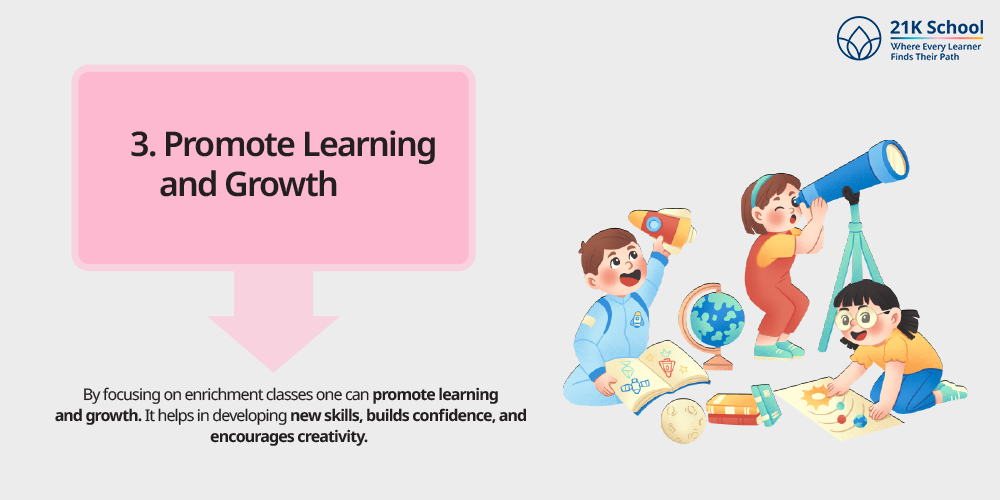
By focusing on enrichment classes one can promote learning and growth. It helps in developing new skills, builds confidence, and encourages creativity.
Emphasize progress over perfection, and celebrate milestones, no matter how simple and small it is. Guide them to understand that learning outside the classroom can also be as valuable as inside.
4. Foster a Supportive Environment
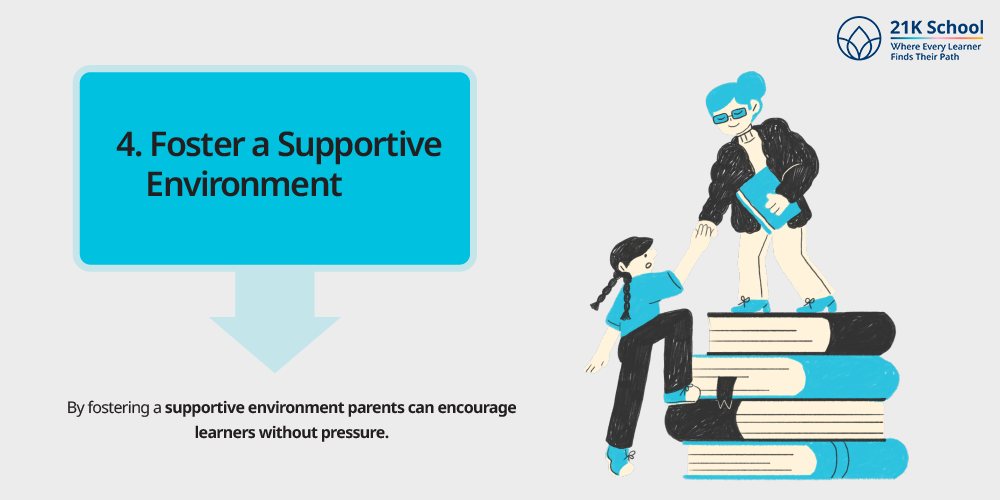
By fostering a supportive environment parents can encourage learners without pressure. Understand their present needs and ask about what they learned.
By showing interest in their activities, projects, and providing positive feedback ensures your valuable presence in their life.
When parents show excitement for learning, kids are more likely to stay motivated and committed.
Conclusion
Enrichment classes are a powerful tool in shaping well-rounded, confident, and capable learners.
They help students go beyond rote learning to discover their passions, build critical life skills, and become lifelong learners.
Whether in schools or through parental support, integrating enrichment activities into a child’s life can make a profound and lasting impact.
Are you someone looking for enrichment classes or want to know more about it as a facilitator or parents, 21K School providing everything you need to know.

